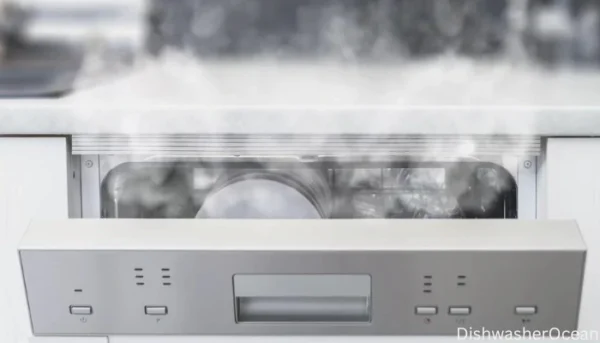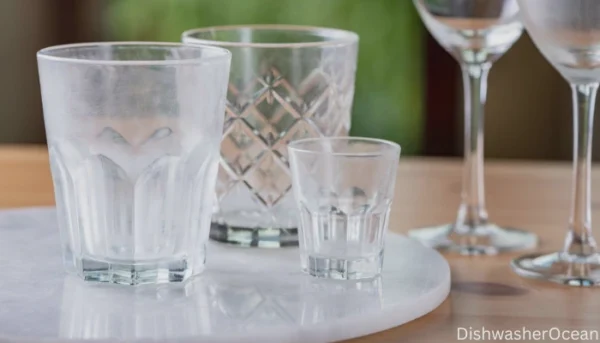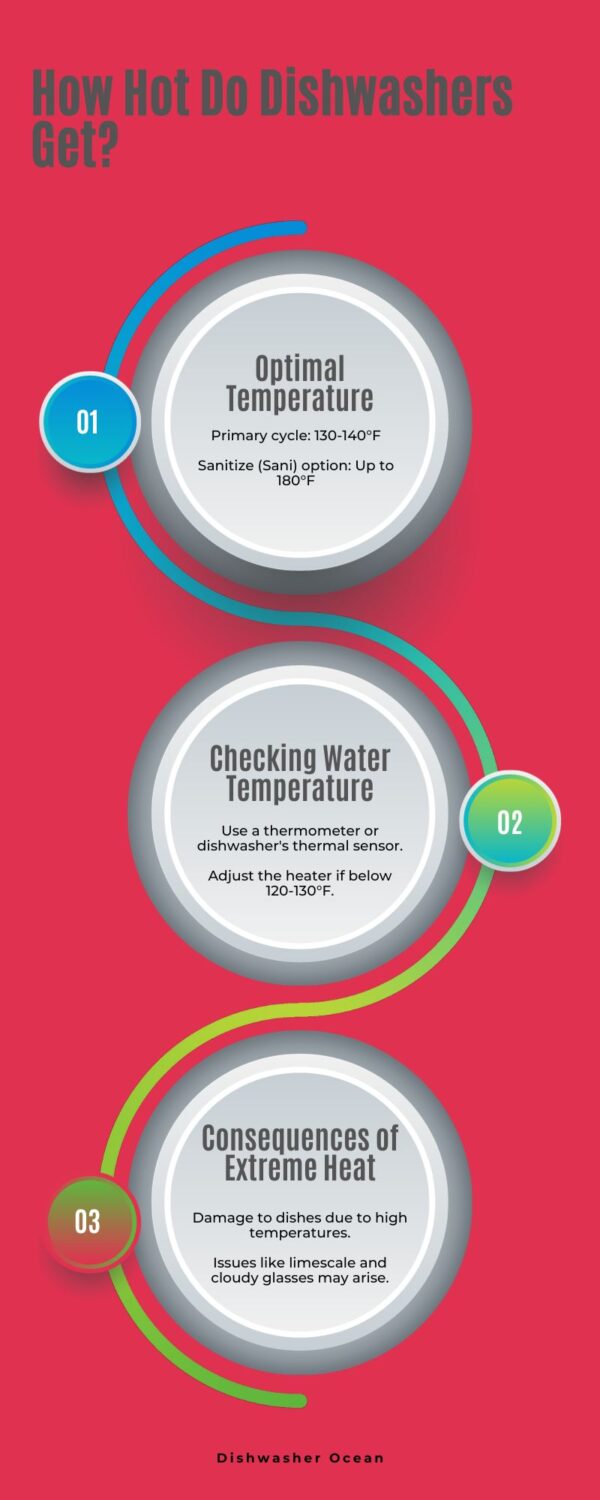If you have a dishwasher in your kitchen, you must have realized its importance in everyday life. Dishwashers make dishwashing a lot easier for the homeowners. But do you know how hot do dishwashers get?
A dishwasher has a built-in water heater by which they heat the water to clean our dishes. But how hot does a dishwasher get? Is overheating of the dishwasher normal? You must have many questions regarding these topics. If you have, you have come to the right place.
In this article, I will be answering all of these questions. Also, we will cover the consequences of extremely hot water, how to check the dishwasher temperature, the required hot water temperature for the sanitizing cycle, etc.
So, let’s get started.

How hot should a dishwasher get to perform optimally?
The temperature of the water in the dishwasher depends upon the different cycles you have selected. However, the average temperature of the appliance during the primary cycle can range between 130 to 140 degrees Fahrenheit.
The dishwasher heats the cold water at a specific temperature so that the detergent would be activated to clean the dishes and utensils, and the dried food residue and grease over the dishes would be dissolved. The dishwasher temperature is fixed by the manufacturers in most of the appliances, but some modern dishwashers come with the option to control the temperature.
If you have selected the sanitize (Sani) option, the dishwasher temperature can go up to 180 degrees Fahrenheit. This is because higher temperature settings eliminate the bacteria and germs from the appliance. It also helps in the drying cycle as the dishes are pre-heated.
The dishwasher uses its heating element to heat up cold water. It is typically located in the bottom of the tub. The heating element also helps the appliance to wash and dry the dishes by converting the water into steam. Most of these heating elements are energy efficient and heat up the water effectively.
How to check the dishwasher’s water temperature?
If you have doubts about your dishwasher’s water temperature and want to ensure it, you can use the methods given below to check the temperature of the water coming from the faucet. However, modern dishwashers have thermal sensors that help find the temperature of the hot water supply.
If your dishwasher doesn’t have a Thermal sensor, you can use a thermometer to determine the temperature.
- Take a glass and fill it with the hot water from the kitchen sink.
- Now, put a thermometer in the glass and observe its reading.

- Keep the thermometer in the glass until the temperature stops rising.
- If the temperature is below the range of 120 to 130 degrees Fahrenheit, then you need to adjust your water heater to reach the optimal washing temperature.
Can high-temperature water cause damage to the dishwasher?
The dishwasher water should be hot enough to clean your dishes properly. As I previously mentioned, if the water coming from the heater is in the range of 120-130 degrees Fahrenheit, the temperature would be considered normal.
But if the water exceeds this limit, it can cause damage to your dishes. If the water from the heater is above 140 degrees Fahrenheit, it would be considered an extreme temperature. Extreme hot water can be harmful to your dishes as It can cause the following issues:
Limescale in the dishwasher
Due to the high temperature of water, the natural calcium and magnesium in the water can form limescale on the inside of the dishwasher. This limescale build-up can disturb the regular functioning of the dishwasher and can cause many other issues.
To get rid of this build-up, you can use any dishwasher cleaner once a month or place a bowl of white vinegar in the middle of an empty dishwasher and start the cycle; the white vinegar will act as cleaner and will remove limescale from your appliance.
The dishwasher cleaner will cleanse your dishwasher from the inside and help to regain its efficiency. As appliance cleaners can reach even the hidden parts of the machine, they are considered to be a better option than manual cleaning.
Cloudy glasses

You may have seen many of your glass dishes appear to be cloudy after a hot water cycle. This happens because, in the high heat condition, the calcium and magnesium in the water build-up to form lime that sticks to the glasses and makes them appear cloudy.
A simple solution to this is soaking your glasses into a bowl filled with white vinegar. The vinegar is acidic and will help in dissolving the dried lime from the glasses. If the build-up is strong, you can warm the vinegar before soaking your glasses into it.
Remember to handle it safely, as glass is a delicate item that can break easily.
Safety features in a dishwasher
As previously mentioned, the dishwasher temperature rises because of the heating element. The hot water dissolves and activates the dishwasher detergent for cleansing processes. Many dishwasher owners may have the misconception that high temperature damages their appliance’s internal parts, but this is a totally wrong concept.
The manufacturers have equipped your dishwasher with multiple safety features to deal with high-temperature water. Many dishwashers are programmed to adjust their temperature according to the dishware.
They have Thermal fuses or Overload protection switches for further safety, which automatically switch off the power when the appliance gets overheated or overloaded. Even some of the advanced dishwasher models have pressurized valves that separate the hot and cold water to avoid the sudden rise of pressure in the dishwasher.
What’s the amount of hot water required in a dishwasher?
In a regular cycle, a dishwasher consumes almost 3 to 5 gallons of hot water, while a compact dishwasher’s average hot water consumption is about 2.7 gallons.
However, there are some powerful dishwashers that can take up to 9 gallons of hot water to run a normal cycle.
Note that these data are only applicable to standard Energy Star-certified dishwashers.
How hot should the dishwasher water be for sanitization?
The sanitized cycle uses hot water to kill all the bacteria and germs. On average, the water temperature during the sanitization process should be above 150°f.
However, some of the advanced power dishwashers can reach temperatures like 190- 194 degrees Fahrenheit because these dishwashers are mostly used in restaurants or hotels where dishes are cleaned in bulk. Note that this data is sourced from the FDA (Food and Drugs Administration).
Dishwasher heat requirements can vary depending on the model of the appliance, so don’t get confused over these things. Some dishwashers can sense types of utensils and adjust their temperature according to dishes, while some have fixed temperatures. So, avoid putting soft plastic dishes that can melt or degrade.
Infographic: How hot does the dishwasher get?

FAQs
Can I use a dishwasher without hot water?
Yes, you can use your dishwasher without hot water, but the dishwasher will take more time than usual to complete the cycle, or maybe some of your dishes will remain unclean. You will need to run multiple cycles to clean your dishware properly without hot water.
Do all dishwashers use hot water?
Most of the dishwashers need a warm water supply to run a wash cycle. The dishwasher heats the water further to reach the optimal temperature. The hot water activates the detergent properly and helps in cleaning the dishes properly.
What is the normal water heater temperature?
Most of the water heaters have a fixed default temperature ranging between 120 to 140°f. However, a temperature above 120°f is considered unsafe for scalding, and a temperature below 120°f can cause bacterial growth in the heater, leading to diseases like Legionnaires.
Conclusion
A temperature ranging between 130 to 140°f during a wash cycle is considered normal for a dishwasher. It uses its own heating element to raise the temperature. The hot water helps to wash dishes properly and dissolves the dried food particles and grease from them. If your appliance has a thermal sensor, you can check the water temperature there. A dishwasher needs almost 3 to 5 gallons of hot water during the wash cycle.
The optimal water temperature can enhance your cleaning results, while high heat can damage your utensils. The most common issues caused by high-temperature water are limescale in the dishwasher and cloudy glasses. If you want to know about it in detail, you can head to that specific topic.
If your dishwasher is not heating accurately, you can call a professional to do repairs. He’ll surely fix your dishwasher.
This was all about the dishwasher temperature guide. I hope you have liked it and found it helpful. If you have any doubts or questions, feel free to ask them in the comment section below. I will be happy to assist you further.
